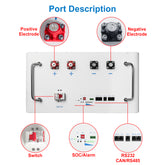Wann sollte ein iPhone-Akku bei 79 Prozent Gesundheit ausgetauscht werden?
Wenn Ihr iPhone in den Akkueinstellungen 79 % Ladezustand anzeigt, fragen Sie sich vielleicht, ob es Zeit für einen Austausch ist. 79 % Ladezustand mag auf den ersten Blick nicht beunruhigend erscheinen, aber dieser Wert kann die Leistung und die Alltagstauglichkeit Ihres Telefons erheblich beeinträchtigen. Wenn Sie verstehen, was 79 % Ladezustand wirklich bedeutet und welche Auswirkungen er auf Ihr iPhone hat, können Sie eine fundierte Entscheidung treffen. In diesem Blogbeitrag untersuchen wir alle Aspekte des Akkuzustands, insbesondere wenn er auf 79 % sinkt, und helfen Ihnen festzustellen, ob es Zeit für einen Austausch ist.
- Verstehen, was 79 % Gesundheit für Ihren iPhone-Akku bedeutet
- Warum 79 % Gesundheit der Wendepunkt für den Ersatz sein könnten
- Wie 79 % Gesundheit die tägliche Leistung und das Laden beeinflussen
- Anzeichen dafür, dass Sie Ihre Batterie bei 79 % Gesundheit austauschen sollten
- Kosten für den Austausch eines iPhone-Akkus bei 79 % Gesundheit
- Best Practices zur Vermeidung einer schnellen Verschlechterung der Batteriegesundheit
- Was passiert, wenn Sie den Batteriewechsel über 79 % Gesundheit hinaus verzögern?
- Vergleich der Batteriezustandsszenarien: 79 % vs. 85 % vs. 90 %
- So ersetzen Sie Ihren iPhone-Akku bei 79 % Gesundheit
- Lohnt es sich, den iPhone-Akku bei 79 % Gesundheit auszutauschen?
- Abschließende Gedanken zu 79 % Gesundheit und wann Maßnahmen ergriffen werden sollten
Verstehen, was 79 % Gesundheit für Ihren iPhone-Akku bedeutet
Der Akkuzustand gibt an, wie gut ein Akku im Vergleich zum Neuzustand Ladung halten kann. Bei einem Zustand von 79 % verfügt der iPhone-Akku nur noch über 79 % seiner ursprünglichen Kapazität. Wenn Ihr Akku beispielsweise ursprünglich für 2.800 mAh ausgelegt war, kann er bei 79 % nur noch etwa 2.212 mAh speichern.
Das Konzept der maximalen Kapazität
Die Funktion „Batteriezustand“ von Apple misst die maximale Kapazität Ihres Akkus. Lithium-Ionen-Akkus verlieren durch chemische Alterung ihre Kapazität. Ein Ladezustand von 79 % bedeutet, dass Ihr Akku deutlich, aber nicht kritisch, gealtert ist.
Spitzenleistungsfähigkeit und Batteriezustand
iPhones versuchen, mit schwachen Akkus umzugehen, indem sie die Leistung einschränken, insbesondere wenn Ihr Telefon unerwartet heruntergefahren wurde. Wenn Ihr Gerät langsamer läuft oder Apps häufig abstürzen, hat Ihr Telefon möglicherweise automatisch die Leistungsverwaltung aktiviert. Bei 79 % Ladezustand ist dies eine häufige Situation.
Warum 79 % Gesundheit der Wendepunkt für den Ersatz sein könnten
Offizielle Empfehlung von Apple
Apple empfiehlt grundsätzlich einen Batteriewechsel, sobald der Ladezustand des Akkus unter 80 % fällt. Da 79 % Ladezustand unter diesem Grenzwert liegen, bietet Apple möglicherweise sogar einen Austausch im Rahmen von AppleCare+ an, sofern Ihr Gerät die Voraussetzungen erfüllt.
Usability-Bedenken bei 79 % Gesundheit
Bei einem Ladezustand von 79 % kann es zu einer kürzeren Akkulaufzeit, längeren App-Ladezeiten, Überhitzung und gelegentlichen Abschaltungen kommen. Diese Probleme können sich auf die tägliche Nutzung und Produktivität auswirken, insbesondere wenn Sie Ihr Gerät stark nutzen.
>>Siehe auch Typische Ladezeit für einen 60-V-Lithium-Ionen-Akku
Wie 79 % Gesundheit die tägliche Leistung und das Laden beeinflussen
Schnellere Batterieentladung
Bei 79 % Ladezustand entlädt sich Ihr Akku schneller als normal. Aktivitäten wie Video-Streaming, Gaming oder GPS-Navigation verbrauchen mehr Strom in kürzerer Zeit.
Erhöhte Ladezyklen
Da der Akku nicht so lange hält, laden Benutzer ihr Telefon in der Regel häufiger auf. Mehr Ladezyklen führen zu einer schnelleren Verschlechterung und verschärfen so die Situation.
Ladegeschwindigkeit und Wärme
Ein abgenutzter Akku mit 79 % Ladezustand kann sich beim Laden stärker erhitzen und länger brauchen, bis er vollständig geladen ist. Diese Symptome sind Anzeichen chemischer Alterung, die schwer zu ignorieren sind.
Anzeichen dafür, dass Sie Ihre Batterie bei 79 % Gesundheit austauschen sollten
Zeichen Nr. 1: Spürbare Verzögerung und träge Leistung
Eine Leistungsdrosselung wird häufig bei geringerer Akkukapazität ausgelöst. Wenn sich Ihr iPhone ungewöhnlich langsam anfühlt und nicht reagiert, kann dies eine direkte Folge von 79 % Gesundheit sein.
Zeichen Nr. 2: Zufällige Abschaltungen
Unerwartete Abschaltungen bei anspruchsvollen Aufgaben sind ein klassisches Symptom. Dies deutet normalerweise darauf hin, dass Ihr Telefon aufgrund einer schwachen Batterie nicht die volle Leistung liefern kann.
Zeichen Nr. 3: Schlechte Akkulaufzeit trotz minimaler Nutzung
Auch wenn Sie Ihr iPhone nicht intensiv nutzen, können 79 % Gesundheit zu deutlich kürzeren Standby-Zeiten führen.
Zeichen Nr. 4: Meldung zu den Batterieeinstellungen
Wenn auf Ihrem iPhone die Meldung „Der Zustand Ihres Akkus ist erheblich beeinträchtigt“ angezeigt wird, ist dies ein direkter Handlungsaufruf – selbst wenn der Akku nur noch zu 79 % geladen ist.
Kosten für den Austausch eines iPhone-Akkus bei 79 % Gesundheit
Kosten für den Austausch außerhalb der Garantie
Der Batterieaustausch bei Apple kostet in den USA für die meisten iPhones normalerweise etwa 69 US-Dollar. Wenn für Ihr Telefon keine Garantie oder AppleCare+ mehr gilt, ist dies ein wichtiger Faktor, den Sie abwägen sollten.
Ersatzoptionen von Drittanbietern
Wenn Ihre Garantie abgelaufen ist und Sie eine kostengünstigere Lösung wünschen, bieten seriöse Reparaturwerkstätten von Drittanbietern häufig günstigere Batteriewechsel an, die Qualität kann jedoch variieren.
DIY-Batteriewechsel
Fortgeschrittene Benutzer entscheiden sich manchmal für den Eigenbau des Akkus. Da jedoch Risiken hinsichtlich Bildschirmschäden, Wasserbeständigkeit und Sicherheit bestehen, ist dieser Weg nur zu empfehlen, wenn Sie Erfahrung mit Elektronik haben.
Best Practices zur Vermeidung einer schnellen Verschlechterung der Batteriegesundheit
Vermeiden Sie extreme Temperaturen
Hitze ist einer der größten Feinde der Akkugesundheit. Vermeiden Sie das Laden oder Verwenden Ihres iPhones in direktem Sonnenlicht oder kalten Umgebungen.
Verwenden Sie optimiertes Laden der Batterie
Aktivieren Sie in den iOS-Einstellungen „Optimiertes Laden des Akkus“. Diese Funktion verkürzt die Ladezeit Ihres iPhones und trägt so zur Verlangsamung der Akkualterung bei.
Vermeiden Sie vollständige Entladungen
Wenn Sie Ihren Akku regelmäßig auf 0 % entladen, kann dies den Verschleiß beschleunigen. Versuchen Sie, den Akku die meiste Zeit zwischen 20 % und 80 % zu halten.
Verwenden Sie MFi-zertifizierte Ladegeräte
Billige, nicht zertifizierte Ladegeräte können Spannungsspitzen verursachen oder Ihr Telefon überhitzen, was zu Batterieverschleiß und potenziellen Sicherheitsrisiken beiträgt.
Was passiert, wenn Sie den Batteriewechsel über 79 % Gesundheit hinaus verzögern?
Verminderte Benutzererfahrung
Das Ignorieren einer Batterie mit 79 % Ladezustand kann zu Verzögerungen, häufigen Abschaltungen und einer insgesamt eingeschränkten Funktionalität führen.
Sicherheitsbedenken
Obwohl dies selten vorkommt, können verbrauchte Batterien aufquellen und eine Brandgefahr darstellen. Wenn Sie bemerken, dass sich Ihr Bildschirm anhebt oder Hitze spürt, handeln Sie sofort.
Reduzierter Wiederverkaufswert
Ein iPhone mit schlechtem Akku erzielt beim Wiederverkauf einen niedrigeren Preis. Wenn Sie Ihr Gerät eintauschen oder verkaufen möchten, kann ein Austausch des Akkus den Wert steigern.
Vergleich der Batteriezustandsszenarien: 79 % vs. 85 % vs. 90 %
|
Batteriezustand |
Auswirkungen auf die Leistung |
Ersatz Dringlichkeit |
|
90 %+ |
Minimal |
Keine Aktion erforderlich |
|
85 % |
Leicht |
Überwachen der Nutzung |
|
79 % |
Bemerkbar |
Austausch empfohlen |
Dieser Vergleich zeigt deutlich, dass 79 % Gesundheit einen kritischen Übergangspunkt darstellen.
So ersetzen Sie Ihren iPhone-Akku bei 79 % Gesundheit
Apple Store oder autorisierter Serviceanbieter
Die zuverlässigste Methode ist die Terminbuchung über die Apple Support App. Stellen Sie vor dem Service sicher, dass Ihre Daten gesichert sind.
Reparaturzentren von Drittanbietern
Stellen Sie sicher, dass das Zentrum hochwertige Teile verwendet und eine Garantie bietet. Lesen Sie Bewertungen und vergewissern Sie sich, dass das Zentrum Erfahrung mit iPhone-Modellen hat.
Was Sie nach dem Austausch erwarten können
Sie werden eine längere Akkulaufzeit, wiederhergestellte Leistung und ein besseres Wärmemanagement bemerken. Ihr iPhone wird sich wieder wie neu anfühlen – auch bei älteren Modellen.
>>Siehe auch: Den Unterschied zwischen EVE MB31- und LF304-Batterien verstehen
Lohnt es sich, den iPhone-Akku bei 79 % Gesundheit auszutauschen?
Kosten-Nutzen-Analyse
Die Wiederherstellung der iPhone-Leistung ist mit 69 Dollar deutlich günstiger als der Kauf eines neuen Geräts. Ist das Telefon ansonsten in gutem Zustand, ist ein Akkuwechsel bei 79 % Ladezustand eine gute Entscheidung.
Berücksichtigen Sie das Alter Ihres iPhones
Bei neueren Modellen (iPhone 12 und höher) kann ein Austausch bei 79 % Funktionszustand die Lebensdauer um weitere 1–2 Jahre verlängern. Bei deutlich älteren Telefonen kann ein Upgrade sinnvoller sein.
Abschließende Gedanken zu 79 % Gesundheit und wann Maßnahmen ergriffen werden sollten
Wenn Ihr iPhone-Akku zu 79 % geladen ist, liegt er knapp unter der empfohlenen Schwelle für einen Austausch. Dieser Ladezustand führt oft zu Leistungseinbußen, die den täglichen Gebrauch beeinträchtigen können. Ob Unannehmlichkeiten durch häufiges Laden, Frust über langsame Apps oder das Risiko unerwarteter Abschaltungen – ein Ladezustand von 79 % ist ein Signal, auf das Sie achten sollten.
Der Austausch des iPhone-Akkus ist eine proaktive und kostengünstige Lösung, die die Lebensdauer Ihres Geräts verlängert und seine Zuverlässigkeit wiederherstellt. Warten Sie nicht, bis Ihr Telefon unbrauchbar wird – wenn Sie jetzt handeln, sparen Sie später Geld und Ärger.
Zusammenfassend lässt sich sagen, dass 79 % Gesundheit nicht nur eine Zahl sind – es ist ein Warnsignal, dass Ihr iPhone in die Jahre kommt und ein neuer Akku gut vertragen würde. Handeln Sie, bevor aus kleinen Ärgernissen größere Störungen werden.



















Leave a comment
All blog comments are checked prior to publishing